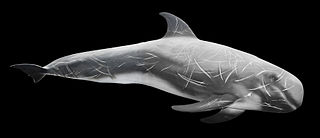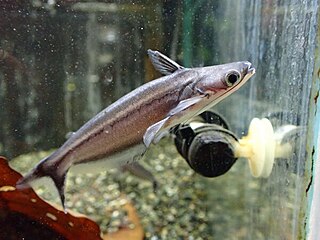
Catfish are a diverse group of ray-finned fish. Named for their prominent barbels, which resemble a cat's whiskers, catfish range in size and behavior from the three largest species alive, the Mekong giant catfish from Southeast Asia, the wels catfish of Eurasia, and the piraíba of South America, to detritivores, and even to a tiny parasitic species commonly called the candiru, Vandellia cirrhosa. Neither the armour-plated types nor the naked types have scales. Despite their name, not all catfish have prominent barbels or "whiskers". Members of the Siluriformes order are defined by features of the skull and swimbladder. Catfish are of considerable commercial importance; many of the larger species are farmed or fished for food. Many of the smaller species, particularly the genus Corydoras, are important in the aquarium hobby. Many catfish are nocturnal, but others are crepuscular or diurnal.

Risso's dolphin is a dolphin, the only species of the genus Grampus. Some of the closest related species to these dolphins include: pilot whales, pygmy killer whales, melon-headed whales, and false killer whales.

Loricariidae is the largest family of catfish, with 92 genera and just over 680 species. Loricariids originate from freshwater habitats of Costa Rica, Panama, and tropical and subtropical South America. These fish are noted for the bony plates covering their bodies and their suckermouths. Several genera are sold as "plecos", notably the suckermouth catfish, Hypostomus plecostomus, and are popular as aquarium fish.

The Aspredinidae are a small South American family of catfishes also known as the banjo catfishes, with about 43 species.

Akysis is the largest genus of catfishes of the family Akysidae.

Platysilurus is a genus of long-whiskered catfishes native to South America.
Rhinodoras is a genus of thorny catfishes native to South America.

Auchenipterichthys is a genus of driftwood catfishes found in South America.

Sisoroidea is a superfamily of catfishes. It contains the four families Amblycipitidae, Akysidae, Sisoridae, and Erethistidae; many sources also include Aspredinidae. With Aspredinidae, this superfamily includes about 42 genera and 230 species.
Pseudolithoxus is a genus of suckermouth armored catfishes with five described species from the basins of the Orinoco, Casiquiare and upper Rio Negro in Venezuela. Additionally, a possibly undescribed species is known from the Trombetas and Nhamundá rivers in Brazil.
Acanthobunocephalus nicoi is one of two species of catfish in the genus Acanthobunocephalus of the family Aspredinidae. This species is known from only three localities and appears to be restricted to the upper Orinoco River system of Venezuela and possibly the upper Rio Negro system of Brazil.

Dupouyichthys sapito is the only species of banjo catfishes in the genus Dupouyichthys. This species appears to be restricted to the Magdalena and Maracaibo basins. D. sapito is a small, armored aspredinid, growing up to 27 millimetres (1.1 in) SL, distinguished from all other aspredinids by having only one set of paired pre-anal-fin plates. Also, the bony ornamentation of its skull is better developed than its close relatives. It is found in river banks with vegetation.
Aspredinichthys is a genus of banjo catfishes found in fresh and brackish waters in tropical South America from the Orinoco delta, through the Guianas, to the Amazon delta. Both species are found in lower portions of rivers and in coastal waters of northern South America from Venezuela to northern Brazil where they are benthic fish.
Ernstichthys is a genus of banjo catfishes that occurs in the Amazon and Orinoco basins.
Hoplomyzon is a genus of banjo catfishes that are native to tropical South America.
Micromyzon akamai is a species of catfish in the family Aspredinidae.

Bunocephalus is a genus of banjo catfishes from South America. It is found in Magdalena, Orinoco, Amazon, Paraguay-Paraná, and São Francisco Rivers. It is also the only aspredinid genus found west of the Andes, found in the Atrato, San Juan, and Patía Rivers. This genus is a part of the family Aspredinidae, known as banjo catfishes for their large, flattened heads and slender tails that give the appearance of a banjo. Most species exhibit cryptic coloration, and the same holds true among Bunocephalus species. The skin is completely keratinized and is covered by large, unculiferous tubercles. Bunocephalus species may reach up to 13 centimetres SL.

Auchenipterus is a genus of driftwood catfishes.

Pseudobunocephalus is a genus of banjo catfishes.

Hughmilleriidae is a family of eurypterids, an extinct group of aquatic arthropods. The hughmilleriids were the most basal members of the superfamily Pterygotioidea, in contrast with the more derived families Pterygotidae and Slimonidae. Despite their classification as pterygotioids, the hughmilleriids possessed several characteristics shared with other eurypterid groups, such as the lanceolate telson.












